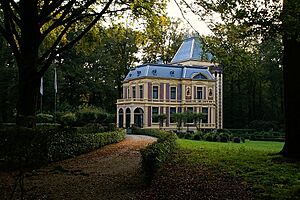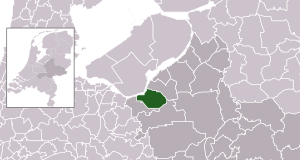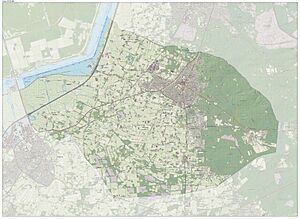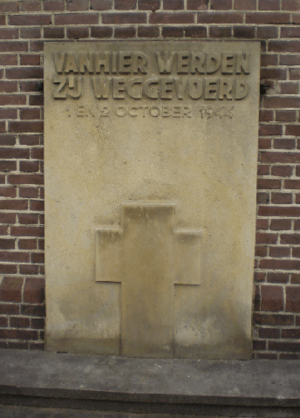Putten facts for kids
Quick facts for kids
Putten
|
|||
|---|---|---|---|
|
Town and municipality
|
|||

Groot Spriel
|
|||
|
|||

Location in Gelderland
|
|||
| Country | Netherlands | ||
| Province | Gelderland | ||
| Government | |||
| • Body | Municipal council | ||
| Area | |||
| • Total | 87.41 km2 (33.75 sq mi) | ||
| • Land | 85.12 km2 (32.87 sq mi) | ||
| • Water | 2.29 km2 (0.88 sq mi) | ||
| Elevation | 17 m (56 ft) | ||
| Population
(May 2014)
|
|||
| • Total | 24,148 | ||
| • Density | 284/km2 (740/sq mi) | ||
| Demonym(s) | Puttenaar | ||
| Time zone | UTC+1 (CET) | ||
| • Summer (DST) | UTC+2 (CEST) | ||
| Postcode |
3880–3882
|
||
| Area code | 0341 | ||
Putten is a town and a local government area (called a municipality) in the Gelderland province of the Netherlands. In 2014, about 24,148 people lived there.
Putten is located near the old Zuiderzee, which was once a large sea. To the east, you'll find the Veluwe, which is the biggest national park in the Netherlands. Farmlands surround Putten to the north, east, and west.
Contents
Exploring Putten's Neighborhoods
Putten is made up of several smaller areas. These are like different neighborhoods or villages that together form the municipality.
- Bijsteren
- Diermen
- Gerven
- Halvinkhuizen
- Hell
- Hoef
- Huinen
- Koudhoorn
- Krachtighuizen
- Putten
- Steenenkamer
- Veenhuizerveld.
A Look Back: Putten's History
Early Days to World War II
The first official document mentioning Putten is from the year 855. However, people lived in small settlements here even during the time of the Roman Empire. After the main church was built in the 10th century, Putten became the center for many smaller communities nearby.
Some parts of Nijkerk and Voorthuizen were once part of Putten. But later, in 1530, Nijkerk became its own independent community. Voorthuizen also became independent later on.
Until 1356, the coastline around Putten changed often. Water from the sea would flood the farmlands in the west. To stop this, a large wall called a dyke was built. Even with the dyke, the water was still a danger. The dyke broke through many times. The last big flood happened in 1916, covering large areas of Putten in water.
After the Afsluitdijk was built in the north of the Netherlands (between 1927 and 1933), the Zuiderzee turned into a lake. This meant the water no longer threatened Putten.
Farming has always been a very important way for people in Putten to earn money. From the 17th to the 19th centuries, making paper was also a key industry.
Around the late 1800s, tourism started to grow. This was helped by the arrival of the railway in 1863. It made it easier for people from other towns to visit Putten for holidays. Many stayed in the guesthouses that were built. Some visitors were even patients with illnesses like tuberculosis. They came to Putten to get better, enjoying the sunlight and clean air in special healing centers called sanatoria.
Putten has also faced many difficult times due due to wars. During the 15th, 16th, and 17th centuries, the town was burned down at least five different times.
Putten During World War II
One of the largest and most tragic events during World War II in the Netherlands happened in Putten. On October 1 and 2, 1944, many of the men from the town were taken away. Most of them sadly died in concentration camps like Neuengamme and Birkenau.
This terrible event was a punishment for an attack by the local resistance group. The resistance had attacked a German officer near Nijkerk. After the war, two German officers responsible for this action were found guilty.
Every year, on October 1 and 2, Putten remembers this sad time. There is a war memorial at Putten Church and a special garden called the Vrouwtje van Putten Herdenkingshof (Lady of Putten Memorial Garden). These places help people remember the event and the many lives that were lost.
| Total number of men taken away | 661 |
| Released in Amersfoort | 59 |
| Sent to Neuengamme | 602 |
| Jumped out of the train on the way to Neuengamme | 13 |
| Arrived in Neuengamme | 589 |
| Returned to Putten after the war ended | 49 |
| Died in German concentration camps | 540 |
| Killed during the raid | 7 |
| Died shortly after returning home | 5 |
| Total number of deaths | 552 |
Putten's Economy Today
Farming is still important in Putten. However, most jobs are now in the service industry. This includes many shops and businesses that help people. Tourism is also a big part of the economy. Visitors come to Putten because of its different landscapes and the beach at the Ring Lake (Strand Nulde).
Every Wednesday, Putten hosts a large market. You can find fresh produce and food there. It's the biggest market in the northwest Veluwe area.
Getting Around Putten
Putten is located next to the A28 highway. This major road connects the city of Utrecht with the northern parts of the Netherlands.
The town also has its own train station. This station is on the train line that runs between Utrecht and Zwolle. There are also bus services available for getting around.
Famous People From Putten
Many interesting people have connections to Putten. Here are a few:
- Hendrik van Boeijen (1889–1947), a politician.
- Danielle Goldstein (born 1985), an American-Israeli horse rider who lives in Putten.
- Ummet Ozcan (born 1982), a Dutch-Turkish DJ and music producer.
- Sander Duits (born 1983), a football player who played many games for clubs, including SDC Putten.
- Tjarda Struik (born 1986), a politician and a "blindfluencer" (someone who shares their experiences with blindness online).
Images for kids
See also
 In Spanish: Putten para niños
In Spanish: Putten para niños











